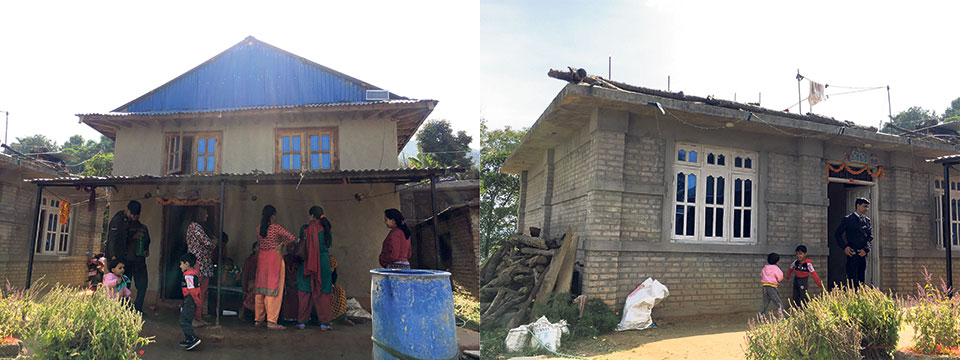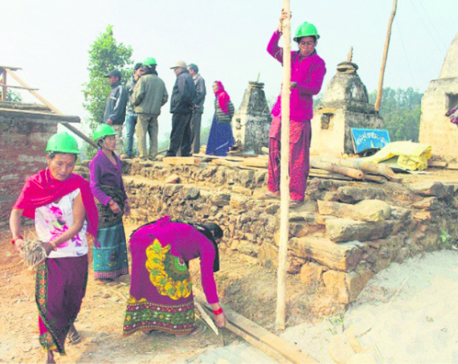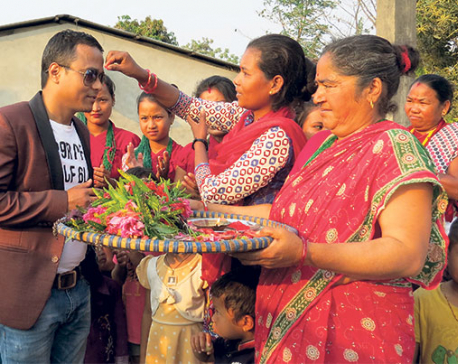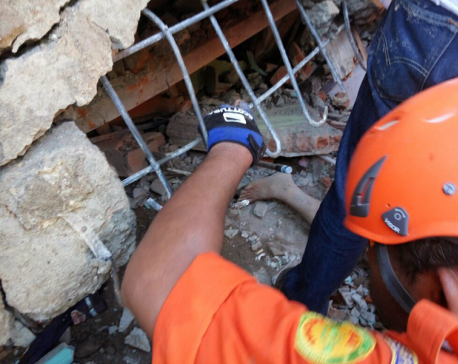
OR
Earthquake Housing Reconstruction Program
Govt grant expediting private housing reconstruction
Published On: November 4, 2019 08:04 AM NPT By: Muna Sunuwar | @TheMunaSun

DHULIKHEL, Nov 4: Krishna Prasad Dhital, 48 of Dhulikhel municipality with his family is preparing to move into his newly-constructed home within this week. He has constructed the two-room home with an investment of Rs 1 million of which, Rs 300,000 was provided by the government as subsidy. “Had it not been for the grant, we would face financial problems and the reconstruction would be pushed back,” Dhital said.
The government provides Rs 300,000 each to the eligible beneficiaries in three installments upon the completion of prespecified conditions assuring the compliance to the approved reconstruction guidelines. The government provides the first tranche of Rs 50,000 after the beneficiary signs an agreement to participate in the program. The second tranche of Rs 150,000 is released upon completion of construction up to plinth level followed by the third tranche of Rs 100,000 upon the completion of roof-band level.
“Engineers who came for inspection had told us to not use the old house but we had no option so we continued to stay here,” Saraswati Dhital, Krishna’s wife, told Republica, adding: “We are excited to shift to our new home.”Krishna shared though it took a long time to construct his new home, he received all three installments with ease.
Similarly, 78 years old Megh Kumari Bhujel of Patlekhet is now living in her newly reconstructed home. She built the house in Rs 600,000. “Now that the construction is complete, I have received all tranches,” she shared.
Kamali Tamang, a homestay operator at Kavrepalanchowk municipality shared her success story with a team of delegates from World Bank who had reached Patlekhet, Kavrepalanchowk to visit the earthquake housing reconstruction site. “Even after the earthquake hit the district, we were able to continuously operate our business as we were able to reconstruct the houses on time,” Tamang shared.
According to National Reconstruction Authority (NRA), 816,450 beneficiaries are eligible for housing grants. The authority has signed housing agreement with 776,918 beneficiaries. Of those, 768,555 beneficiaries have received the first tranche of Rs 50,000, and of the 628,996-second tranche applicants, 615,117 have received the second tranche. The government has approved 624,686 applications for the second tranche. “There are a total of 534,385 applicants for the third tranche, of which 530,438 have been approved,” according to the NRA, “Likewise, 512,178 have already received the third tranche.”
However, Haribol Dhital who cannot speak has not been able to reconstruct his house. Though he has received the first tranche, high labor cost has left him helpless. “I have started the construction but the lack of finance has halted further the construction work,” she told.
Speaking at the interaction with beneficiaries CEO of the NRA, Sushil Gyawali said the Nepal Rastra Bank has decided to add only 2% on the base interest rate and other banks will eventually follow the rule. “The government has decided to pay back 5% of the banks’ interest rates for the beneficiaries of the project,” he said.
The high-interest rate imposed by banks and financial institutions is one of the reasons the reconstruction of private housing has been pushed back. The people of Kavrepalanchowk have been paying as much as 26% interest rate for loans from BFIs. Binod Prasad Tiwari, a resident of Patlekhet said microfinances are levying 16% interest rate and banks 26% on the loans.
The NRA has surveyed a total of 1,036,568 households and identified 69,973 retrofitting beneficiaries. A total of 306,858 grievances have been registered for the reconstruction project. Under the earthquake housing reconstruction project 471,739 houses have been constructed while 665,523 are under construction.
The financial assistance from the bank worth US $ 500 million (approximately Rs 50 billion) to the government of Nepal supports approximately 151,000 houses in 14 districts severely impacted by the 2015 earthquake. The project has adopted owner-driven housing reconstruction approach that promotes earthquake-resistant building techniques and materials. It aims at improving long-term resilience through a culture of safer and sustainable housing and settlements.
The government indicating the financial resources insufficient had asked the bank to look into increasing the support. “We are far short of the necessary resources to complete the reconstruction work,” Yuba Raj Khatiwada, minister of finance had said, addressing the World Bank delegates during a visit to Manthali in 2018. “We look forward to scaling up the resources to meet the reconstruction commitments by managing financing gap in post-earthquake reconstruction.”
According to the World Bank, second additional financing of amounting US$ 300 million is under preparation, which will finance second and third tranches of approximately 129,000 beneficiaries. “The board of the World Bank is involved in supporting the government of Nepal for fast recovery. It is impossible to fund 100% of the investment in the project,” said Jorge Chavez Presa, spokesperson for the executive directors who went on a site visit. “The financial constraint of Rs 300,000 also looks to get to the most people. It will allow the project to have higher penetration so that most of the people will have access to the assistance.”
You May Like This

Reviving homestay in Gorkha challenging
GORKHA, Dec 23: On 25 April 2015, the country witnessed an unexpected disaster. Human lives, cattle, and infrastructures were destroyed by... Read More...

Homestays in Syangja to reopen starting tomorrow
POKHARA, Feb 8: Sirubari Homestay, considered to be the oldest homestay in Nepal, will be reopened from this week. All... Read More...

The Latest: Indonesia earthquake death toll rises to 102
MEUREUDU, Indonesia, Dec 8: The Latest on a magnitude 6.5 earthquake in Indonesia's Aceh province (all times local): ... Read More...










Just In
- NRB introduces cautiously flexible measures to address ongoing slowdown in various economic sectors
- Forced Covid-19 cremations: is it too late for redemption?
- NRB to provide collateral-free loans to foreign employment seekers
- NEB to publish Grade 12 results next week
- Body handover begins; Relatives remain dissatisfied with insurance, compensation amount
- NC defers its plan to join Koshi govt
- NRB to review microfinance loan interest rate
- 134 dead in floods and landslides since onset of monsoon this year








Leave A Comment